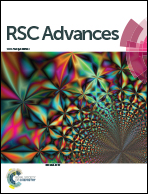Cage to cage study of ionic liquid and cyclic oligosaccharides to form inclusion complexes†
Abstract
The inclusion complexation behaviour, characterization and binding ability of trihexyltetradecylphosphonium chloride with α and β-cyclodextrin have been investigated both in aqueous solution and solid state by means of 1H NMR, surface tension, conductivity, density, viscosity, refractive index, FTIR and HRMS measurements. The shifts in the NMR spectra reveal that part of the ionic liquid is inserted into the cyclodextrin molecules. Surface tension and conductivity studies approve the 1 : 1 stoichiometry of the inclusion complex while density, viscosity and refractive index measurements show the interaction of the ionic liquid with the host molecules. FTIR and HRMS studies confirm the inclusion phenomenon. Binding constants have been evaluated using a non linear programme and NMR study, indicating a higher degree of encapsulation in the case of β-cyclodextrin compared to α-cyclodextrin.

- This article is part of the themed collection: Editors’ collection: Supramolecular Chemistry


 Please wait while we load your content...
Please wait while we load your content...